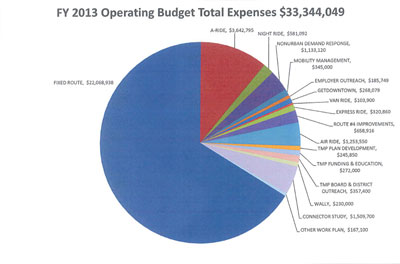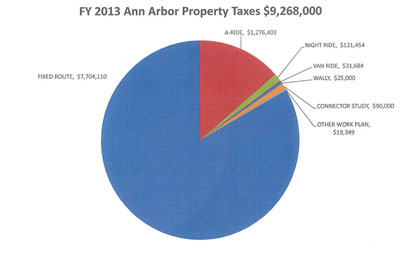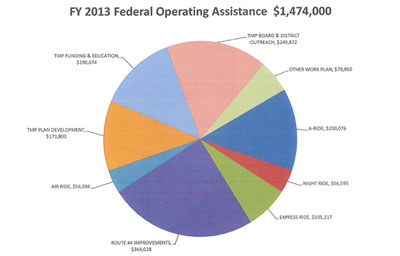AATA Budget Preview: No Deficit
A small $22,692 surplus is projected in the draft budget of the Ann Arbor Transportation Authority for its upcoming fiscal year, which begins on Oct. 1, 2012. The budget is attached to the Ann Arbor city council online agenda for its Sept. 17 meeting. It shows that the AATA is expecting the 2013 fiscal year essentially to balance expenses against revenues in an overall operating budget of $33,344,048.
That’s an increase of around $3 million over the current year’s budget, which called for the AATA to spend $30,410,622 against only $29,418,998 in revenues. The nearly $1 million planned deficit for that fiscal year – which ends on Sept. 30, 2012 – was previously characterized by the board as a way to “catapult” the organization forward by offering some increased levels of service, in advance of AATA’s possible transition to a new, broader transit authority. Despite budgeting for that $1 million deficit, current projections included in the FY 2013 budget show that the AATA now expects to finish FY 2012 with a much smaller deficit of $296,378 – about one-third of what was projected.
For the new FY 2013 budget, an increase in revenues is accounted for in part by increased passenger revenues. Increased ridership is expected to generate about $750,000 more in fares in the coming year, compared to the fares collected in the fiscal year that’s nearing its end on Sept. 30. The AATA is also budgeting for about $300,000 more in state operating assistance for FY 2013. And the AATA anticipates about $3 million more in federal operating assistance, compared to what it actually received in the current fiscal year. A chunk of that is for a connector study from the northeastern part of the city to its southern edge.
Ann Arbor’s local transit tax, levied at a rate of just over 2 mills, is expected to show stable revenue levels compared to FY 2012, generating about $9.3 million. For the coming year, the AATA does not expect to use any of the local tax levy to help fund commuter express services from Canton and Chelsea, as it has since launching the service. Instead, the AATA will be using $105,217 of federal funds to cover that cost. Responding to an emailed query from The Chronicle, AATA controller Phil Webb explained that the AATA is taking advantage of newly expanded regulations that allows up to $1.47 million of AATA’s programmed federal funds to be used to pay for early investments in the AATA’s 5-year transit program. The AATA released the final draft of that plan on Sept. 5, 2012.
The city of Ann Arbor’s online Legistar system does not show any previous occasions when the draft AATA budget has been forwarded to the council as a communication or a report. Over the past year, however, Stephen Kunselman – who represents Ward 3 on the council – has been vocal about calling for the AATA to do that. He wanted an opportunity to comment on the AATA’s budget as required under a 1974 agreement between Ann Arbor and the AATA. [.pdf of 1974 agreement]. Kunselman’s most recent call for the AATA to submit its budget for council review came at the council’s Sept. 4, 2012 meeting.
That was the same meeting when the council – with two absences on the 11- member body – turned down a $60,000 request for the city’s share of an alternatives analysis for a connector system. That connector would run along the Plymouth/State corridor, from US-23 and Plymouth southward along Plymouth to State Street, extending south to I-94. Although the council is expected to reconsider the request at its Sept. 17 meeting, with a full complement of the council present, it’s not clear the council will have the eight votes necessary to make the budget change.
The city’s $60,000 funding share for that study would be part of a $300,000 local match component, the rest of which is being paid by the AATA and the University of Michigan. The study has a total project budget of $1.5 million, $1.2 million of which is being funded through a federal grant. The AATA FY 2013 budget factors in the city’s $60,000 share for that study.
The AATA board will have the FY 2013 budget on its Sept. 27 meeting agenda. [.pdf of draft AATA FY 2013 budget]
Charts
Included in the material attached to the city council agenda are four pie charts created by the AATA.

AATA FY 2013 draft operating budget. The bulk of expenses supports the AATA’s fixed route service (dark blue), which is the basic bus service that people typically associate with AATA. Also significant are the A-Ride paratransit service (red) and the AirRide airport service (teal). The connector study also makes up a significant portion of the overall operating expenses.

AATA FY 2013 revenue. The AATA gets roughly the same amount from property taxes (red) as it does from the state (green). Passenger fares (dark blue) and federal assistance (purple) make up comparable shares.

AATA FY 2013 local millage dollar usage. The majority of the local millage goes to support the basic fixed route (blue) and paratransit service (red). Putting the connector study and WALLY (north-south commuter rail) together brings the amount the AATA will be spending on planning efforts in the coming year at $115,000.

AATA FY 2013 federal operating expenses. Efforts connected to the transit master plan (TMP) are those that involve the AATA’s effort to expand its area of service and governance in the form of a new transit authority to be incorporated as The Washtenaw Ride. TMP efforts include the salmon wedge and (counterclockwise) the light blue and orange wedges. The dark purple wedge represents Route #4 improvements for the service between Ann Arbor and Ypsilanti.
Other Facts
The draft budget includes several facts of interest.
The AATA expects to deliver 6.8 million passenger trips next year during 284,200 hours of service. That works out to a cost per service hour of $117 per hour, about $5 more than last year.
To deliver those trips, the AATA expects to use 623,000 gallons of bio-diesel fuel.
The AATA will be have 125 full-time equivalent bus drivers next year, which is 2.5 more than last year. That includes 110 full-time positions and 20 part-time. The top of the wage scale for AATA drivers is $24 per hour. The total amount paid in union wages is about $8.6 million. Management wages total $3.9 million, of which $2.6 million goes to administration.
Update on Sept 21, 2012: The board’s information packet for its upcoming Sept. 27 meeting includes some negative news with respect to the budget, which the board is expected to ratify at that meeting. The AATA will be receiving about $800,000 less than expected in operating assistance from the state. The AATA’s response was to identify some expense reductions, but that left the AATA still $300,000 short, which will be covered with fund balance reserve.
From the draft of the board’s resolution, which it will be asked to approve:
WHEREAS, on September 14, 2012, notification was received from the Michigan Department of Transportation (MDOT) that a new interpretation of the State’s Operating Assistance Formula would decrease AATA’s FY 2013 operating assistance by approximately $803,500, and
WHEREAS, Staff subsequently worked diligently to propose expense reductions in the budget that would neither negatively impact the public nor diminish its published transit services, however, there remains approximately $300,000 of uncovered expenses, and
WHEREAS, the Board has previously established an Unrestricted Net Assets Policy for instances when “it is necessary for the AATA to have on hand a prudent reserve to cover the expenses necessary to maintain service levels in the event of interruption or delay of the receipt of state or federal funding,” now therefore
IT IS RESOLVED, that AATA shall utilize approximately $300,000 of its Unrestricted Net Assets for the purpose of balancing the FY2013 Operating Budget of $32,700,181, that such budget is hereby approved to become effective October 1, 2012, and that the budget is assigned to the Performance Monitoring and External Relations Committee (PMER) for appropriate monitoring
The Chronicle could not survive without regular voluntary subscriptions to support our coverage of public bodies like the Ann Arbor Transportation Authority. Click this link for details: Subscribe to The Chronicle. And if you’re already supporting us, please encourage your friends, neighbors and colleagues to help support The Chronicle, too!




